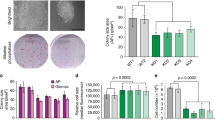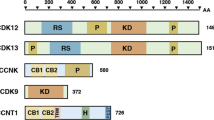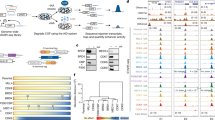Abstract
The transcription factor E2F mediates cell cycle-dependent expression of genes important for cell proliferation in response to growth stimulation. To further understand the role of E2F, we utilized a sensitive subtraction method to explore new E2F1 targets, which are expressed at low levels and might have been unrecognized in previous studies. We identified 33 new E2F1-inducible genes, including checkpoint genes Claspin and Rad51ap1, and four genes with unknown function required for cell cycle progression. Moreover, we found three groups of E2F1-inducible genes that were not induced by growth stimulation. At least, two groups of genes were directly induced by E2F1, indicating that E2F1 can regulate expression of genes not induced during the cell cycle. One included Neogenin, WASF1 and SGEF genes, which may have a role in differentiation or development. The other was the cyclin-dependent kinase inhibitor p27Kip1, which was involved in suppression of inappropriate cell cycle progression induced by deregulated E2F. E2F1-responsive regions of these genes were located more upstream than those of typical E2F targets and did not have typical E2F sites. These results indicate that there are groups of E2F1 targets, which are regulated in a distinct manner from that of typical E2F targets.
This is a preview of subscription content, access via your institution
Access options
Subscribe to this journal
Receive 50 print issues and online access
$259.00 per year
only $5.18 per issue
Buy this article
- Purchase on Springer Link
- Instant access to full article PDF
Prices may be subject to local taxes which are calculated during checkout






Similar content being viewed by others
References
Alevizopoulos K, Catarin B, Vlach J, Amati B . (1998). EMBO J 17: 5987–5997.
Balzer HJ, Baumlein H . (1994). Nucleic Acids Res 22: 2853–2854.
Cam H, Balciunaite E, Blais A, Spektor A, Scarpulla RC, Young R et al. (2004). Mol Cell 16: 399–411.
Chini CC, Chen J . (2003). J Biol Chem 278: 30057–30062.
Dimri GP, Itahana K, Acosta M, Campisi J . (2000). Mol Cell Biol 20: 273–285.
Dyson N . (1998). Genes Dev 12: 2245–2262.
Elbashir SM, Harborth J, Weber K, Tuschl T . (2002). Methods 26: 199–213.
Ishida S, Huang E, Zuzan H, Spang R, Leone G, West M et al. (2001). Mol Cell Biol 21: 4684–4699.
Ito E, Iwahashi Y, Yanagisawa Y, Suzuki Y, Sugano S, Yuasa Y et al. (1999). Gene 228: 93–100.
Iwanaga R, Ohtani K, Hayashi T, Nakamura M . (2001). Oncogene 20: 2055–2067.
Kowalik TF, DeGregori J, Schwarz JK, Nevins JR . (1995). J Virol 69: 2491–2500.
Kumagai A, Dunphy WG . (2000). Mol Cell 6: 839–849.
Lee J, Kumagai A, Dunphy WG . (2003). Mol Cell 11: 329–340.
Lomazzi M, Moroni MC, Jensen MR, Frittoli E, Helin K . (2002). Nat Genet 31: 190–194.
Muller H, Bracken AP, Vernell R, Moroni MC, Christians F, Grassilli E et al. (2001). Genes Dev 15: 267–285.
Nagase T, Seki N, Ishikawa K, Ohira M, Kawarabayasi Y, Ohara O et al. (1996). DNA Res 3: 321–329, 341–354.
Nevins JR, Leone G, DeGregori J, Jakoi L . (1997). J Cell Physiol 173: 233–236.
Ohtani K, Iwanaga R, Nakamura M, Ikeda M, Yabuta N, Tsuruga H et al. (1999). Oncogene 18: 2299–2309.
Ohtani K, Tsujimoto A, Ikeda M, Nakamura M . (1998). Oncogene 17: 1777–1785.
Park MS, Rosai J, Nguyen HT, Capodieci P, Cordon-Cardo C, Koff A . (1999). Proc Natl Acad Sci USA 96: 6382–6387.
Polager S, Kalma Y, Berkovich E, Ginsberg D . (2002). Oncogene 21: 437–446.
Qi H, Fournier A, Grenier J, Fillion C, Labrie Y, Labrie C . (2003). Endocrinology 144: 1742–1752.
Qin XQ, Livingston DM, Kaelin Jr WG, Adams PD . (1994). Proc Natl Acad Sci USA 91: 10918–10922.
Ren B, Cam H, Takahashi Y, Volkert T, Terragni J, Young RA et al. (2002). Genes Dev 16: 245–256.
Shan B, Lee WH . (1994). Mol Cell Biol 14: 8166–8173.
Shieh SY, Ahn J, Tamai K, Taya Y, Prives C . (2000). Genes Dev 14: 289–300.
Suetsugu S, Miki H, Takenawa T . (1999). Biochem Biophys Res Commun 260: 296–302.
Symonds H, Krall L, Remington L, Saenz-Robles M, Lowe S, Jacks T et al. (1994). Cell 78: 703–711.
Takahashi Y, Rayman JB, Dynlacht BD . (2000). Genes Dev 14: 804–816.
Trimarchi JM, Lees JA . (2002). Nat Rev Mol Cell Biol 3: 11–20.
Vielmetter J, Kayyem JF, Roman JM, Dreyer WJ . (1994). J Cell Biol 127: 2009–2020.
Wang C, Hou X, Mohapatra S, Ma Y, Cress WD, Pledger WJ et al. (2005). J Biol Chem 280: 12339–12343.
Weinmann AS, Yan PS, Oberley MJ, Huang TH, Farnham PJ . (2002). Genes Dev 16: 235–244.
Wu X, Levine AJ . (1994). Proc Natl Acad Sci USA 91: 3602–3606.
Acknowledgements
We thank K Helin for kindly providing U2OS-ER-E2F1 cells, K Maruyama for p27Kip1 reporters, M Ikeda for critically reading the manuscript, S Morinaga, E Ozono, Y Arioka, A Wakita, R Suzuki and M Murayama for technical assistance, as well as K Ogawa and K Nagata for help in setting up PCR/subtraction procedure. This work was supported in part by a Grant-in-Aid for Scientific Research on Priority Areas from The Ministry of Education, Culture, Sports, Science and Technology, and in part by a grant from NOVARTIS Foundation (Japan) for the Promotion of Science.
Author information
Authors and Affiliations
Corresponding author
Rights and permissions
About this article
Cite this article
Iwanaga, R., Komori, H., Ishida, S. et al. Identification of novel E2F1 target genes regulated in cell cycle-dependent and independent manners. Oncogene 25, 1786–1798 (2006). https://doi.org/10.1038/sj.onc.1209210
Received:
Revised:
Accepted:
Published:
Issue Date:
DOI: https://doi.org/10.1038/sj.onc.1209210
Keywords
This article is cited by
-
Circ-ZNF609 regulates G1-S progression in rhabdomyosarcoma
Oncogene (2019)
-
Functional divergence of the brain-size regulating gene MCPH1during primate evolution and the origin of humans
BMC Biology (2013)
-
Statistical identification of gene association by CID in application of constructing ER regulatory network
BMC Bioinformatics (2009)



